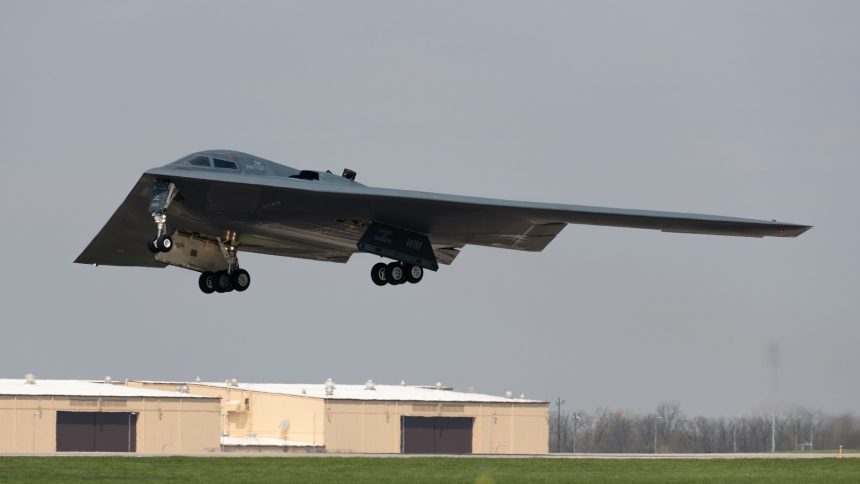More than 125 aircraft, including 7 B-2 stealth bombers, snuck into Iran while other B-2s were sent to Guam as decoys.
Details continue to emerge after the United States struck three nuclear facilities in Iran last night. As we reported earlier, a strike package which included seven B-2 Spirit stealth bombers attacked the Fordow, Natanz and Esfahan nuclear sites in the night between Jun. 21 and 22, 2025.
The attack came as a surprise as U.S. President Donald Trump said, just two days earlier, he would take two weeks before deciding whether to attack Iran. Also, B-2 bombers were sent to Guam before the strike but, as it emerged later, those were only a decoy meant to attract the attention away from the real attack package.
Launch of the strike package
In a briefing with reporters, the Secretary of Defense Pete Hegseth and the Chief of the Joint Staff Gen. Dan Caine provided details about the operations, which has been dubbed “Operation Midnight Hammer.” The operation was described as the biggest attack mission ever performed by the B-2 Spirit and, with an 18-hour duration, the longest B-2 mission since the opening of the Afghanistan war in 2001.
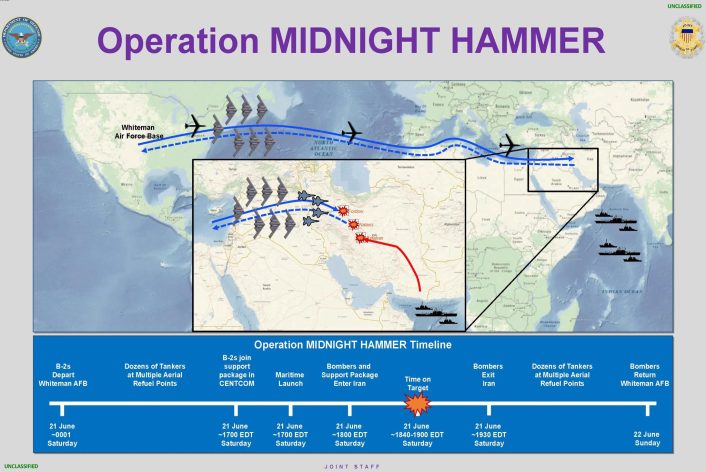
Hegseth said the operation “took months and weeks of positioning and preparation,” with Caine further stating “in a matter of weeks this went from strategic planning to global execution.” This included about 30 tankers, which were deployed the night between June 15 and 16, most of them landing at Ramstein Air Base in Germany and at Morón Air Base and NAS Rota in Spain, as well as Lajes Air Base, in the Azores, which is another location commonly used to support flights over the Atlantic Ocean.
A Base Aérea de Lajes (ICAO: LPLA), no Arquipélago dos Açores, Portugal, recebeu nos últimos dias nada menos que 12 aviões-tanque da USAF. https://t.co/DIH0ja9Bjm pic.twitter.com/RczAUkSp2k
— Revista Força Aérea (@RFA_digital) June 20, 2025
Among the preparations were not only the massive deployment of tankers to Europe, but also deception, as B-2s were also used as decoys. This was meant to throw off any observer, like Open Source Intelligence analysts, which would be able to track the bombers by tracking radio communications and the supporting tankers on flight tracking websites.
Seven B-2s calling SEVILLE CONTROL on VHF over the Straight of Gibraltar on their way back from Iran this morning after refueling over the Mediterranean Sea.
BATT 11 flt (x4 B-2) – advises ATC destination Barksdale AFB
BATT 21 flt (x3 B-2) pic.twitter.com/XYNAyPRXQG
— Thenewarea51 (@thenewarea51) June 22, 2025
In fact, two flights of B-2 Spirits, callsigns MYTEE 11 flight and MYTEE 21 flight, each comprising four aircraft, departed from Whiteman Air Force Base, Missouri, in the early hours of Jun. 21, 2025. Their destination was confirmed as Andersen Air Force Base, located on the Pacific island of Guam.
NITRO KC135s returning to Altus AFB, OK
B2s MYTEE11 FLT & MYTEE21 FLT continuing westbound to destination Andersen AFB, Guam. pic.twitter.com/VrZwURIjRC
— Aircraft Spots (@AircraftSpots) June 21, 2025
One of the bombers had to divert to Hawaii, while another was possibly a spare which returned back, with six bombers arriving at their destination.
B-2 MYTEE 14 (88-0332) diverted to Honolulu #PHNL after declaring an emergency, June 21st 2025. Soundclip with HCF approach and Honolulu tower, the aircraft was on UHF frequencies and not heard: https://t.co/sc438yHJ6s#MYTEE14 #GlobalPower pic.twitter.com/lEf4WRINil
— Coronet_deployments 🇳🇱 🇺🇸 (@CoronetEast) June 22, 2025
At the same time, the B-2s that were directly involved in the attack took off in the opposite direction. An aviation enthusiast living in Missouri posted on X that what he believe were nine B-2s overflying Warsaw, Missouri, heading east. With the officials stating that seven bombers were involved in the strike, he might have seen them together with two spares, as is usual for such missions.
Seems possible if not probable that while every open-source reporter in the world was watching very public and eventually government-confirmed B-2 flights westward, a guy in his backyard in Missouri saw the real, undisclosed and untracked mission heading east https://t.co/fFd2pkRSyk
— Evan Hill (@evanhill) June 22, 2025
Interestingly, the Fordow strike mission was rehearsed many times, according to a former B-2 pilot. This might have further sped up the preparations to launch the Jun. 22 strike.
Former B-2 pilot and No. 2 at Global Strike retired Lt. Gen. Mark Weatherington says the Fordow mission has been reheased “many times for several years.”
— Lucas Tomlinson (@LucasFoxNews) June 22, 2025
Here is how the Joint Staff Gen. Dan Caine described the events:
“At Midnight Friday into Saturday morning, a large B-2 strike package comprised of bombers launched from the continental United States. As part of a plan to maintain tactical surprise, part of the package proceeded to the west and into the Pacific as a decoy, a deception effort known only to an extremely small number of planners and key leaders here in Washington and in Tampa.
The main strike package, comprised of seven B-2 Spirit stealth bombers, each with two crew members, proceeded quietly to the east with minimal communication. Throughout the 18-hour flight into the target area, the aircraft completed multiple inflight refuelings.”

The mentions of the “minimal communication” and “multiple inflight refuelings” are important as these are the elements which might have exposed the main strike package, if not managed correctly. Standard Operational Procedures are in place to reduce as much as possible the communication required during operational flights, as part of the emissions’ control, including the use of unencrypted radios.
Also, with the tankers being the main “weakness” for the stealth bombers, the aircraft were prepositioned on the East coast to avoid attracting unwanted attention when they launched, and the refuelings took place outside of the range of ADS-B receivers in the middle of the Atlantic Ocean.
You don’t sit that many tankers for that many days and have it not for something. https://t.co/AhSMFGz9n0
— Evergreen Intel (@vcdgf555) June 22, 2025
“Once over land, the B-2s linked up with escort and support aircraft in a complex, tightly timed maneuver requiring exact synchronization across multiple platforms in a narrow piece of airspace, all done with minimal communications,” continued Caine. “This type of integration is exactly what our Joint Force does better than anyone else in the world.”
As mentioned in our previous reports, dozens of U.S. aircraft were moved to the Middle East in preparation for the operation. Among them were 10 F-22 Raptors, 12 F-35 Lightning IIs and 12 F-16 Fighting Falcons deployed a few days ago, as well F-15E Strike Eagles and additional F-16s which were already in theater. The Carrier Air Wing of the USS Carl Vinson might also have taken part in the operation.
U.S. Air Force F-15E Strike Eagle in the U.S. Central Command area of responsibility. pic.twitter.com/xxg6F6LlqB
— U.S. Central Command (@CENTCOM) May 30, 2025
Caine stated later on in his statement that “more than 125 U.S. aircraft participated in this mission, including B-2 stealth bombers, multiple flights of 4th and 5th generation fighters, dozens and dozens of air refueling tankers, a guided missile submarine and a full array of Intelligence, Surveillance and Reconnaissance aircraft, as well as hundreds of maintenance and operational professionals.”
Looks like the presence of F-22s and F-35s in last night’s attack on Iran’s nuclear sites has been confirmed by US officials to Al Jazeera. Reposting this as it might be a useful reminder of the roles the Raptor can play. https://t.co/h30UbY9fkn
— David Cenciotti (@cencio4) June 22, 2025
It is unclear which ISR aircraft were employed, however CENTCOM routinely flies ISR missions with RC-135 Rivet Joint and P-8 Poseidon aircraft. U-2 Dragon Lady and MQ-4C Triton high-altitude aircraft might have also been used, as they are often spotted in the area. Heavy jamming was also reported across the entire electromagnetice spectrum.
Reports out of Iran right now of some of the most heavy wide spectrum jamming of the war, radios, GPS, and cell all experiencing heavy degradation.
Most likely US electronic warfare supporting strikes.
— OSINTtechnical (@Osinttechnical) June 21, 2025
On the way to target inside Iran
Once the entire strike package was assembled and “fenced in,” the green light arrived to begin the action.
“At approximatively 5 p.m. Eastern Standard Time last night, and just prior to the strike package entering Iran, a U.S. submarine in the U.S. Central Command Area of Responsibility launched more than two dozen Tomahawk land attack cruise missiles against key surface infrastructure targets at Esfahan,” Caine explained.” As the Operation Midnight Hammer strike package entered Iranian air space, the U.S. employed several deception tactics, including decoys, as the 4th and 5th generation aircraft pushed out in front of the strike package at high altitude and high speed, sweeping in front of the package for enemy fighters and surface-to-air missile threats.”
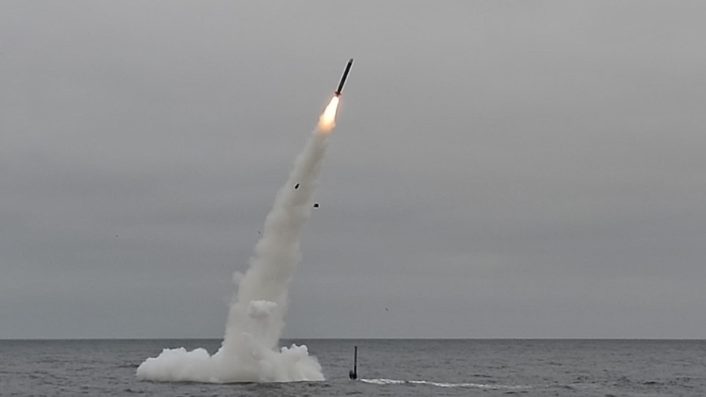
As common in such operations, fighter escorts and SEAD (Suppression of Enemy Air Defenses) assets went ahead to clear the path for the bombers. While not explicitly stated, the mention of the decoys might imply that ADM-160 Miniature Air Launched Decoys (MALD) were employed as another safety measure.
MALD is a low-cost, expendable, air-launched, programmable decoy munition that can replicate the flight profiles and signatures of aircraft and weapons, drawing away the attention from them while confusing enemy integrated air defense systems. The decoy has a stated range of around 500 miles and, in the latest ADM-160C version now operated by the U.S., it is also able to jam enemy radars and communicate through a datalink with allied fighters.
“As the strike package approached Fordow and Natanz, the U.S. protection package employed high-speed suppression weapons to ensure safe passage of the strike package with fighter assets employing preemptive suppressing fires against any potential Iranian surface-to-air threats,” said Caine. “We are currently unaware of any shots fired at the U.S. strike package on the way in.”
The mention of “high-speed suppression weapons” implicitly refers to the use of AGM-88 HARM (High-speed Anti-Radiation Missile) and AGM-88E AARGM (Advanced Anti-Radiation Guided Missile) by the SEAD assets. Among the aircraft that could have employed them are the F-16Cs, specifically Shaw’s Block 50s which are specialized in the SEAD role and are currently deployed to the CENTCOM AOR, and the EA-18Gs of the USS Vinson.
U.S. Air Force F-16 Fighting Falcons patrol the U.S. Central Command area of responsibility. pic.twitter.com/A2McA9VXks
— U.S. Central Command (@CENTCOM) June 5, 2025
On the other hand, the mention of “preemptive suppressing fires” suggests that DEAD (Destruction of Enemy Air Defenses) missions were also conducted against known surface-to-air targets along the route. These might have required the use of standoff weapons, such as the AGM-154 JSOW, AGM-84H SLAM-ER, or glide bombs, such as the GBU-39 SDB and the GBU-53 SDB II.
On target
With the way in cleared of any threats, the strike package finally arrived on the main target, Fordow, and the second target, Natanz.
“At approximatively 6:40 p.m. Eastern Standard Time – 2:10 a.m. Iran time, the lead B-2 dropped two GBU-57 Massive Ordnance Penetrator (MOP) weapons on the first of several aim points at Fordow,” explained Caine. “As the President stated last night, the remaining bombers then hit their targets as well, with a total of 14 MOPs dropped against two nuclear target areas.”
Among the B-2’s unique capabilities is the ability to carry the huge GBU-57 Massive Ordnance Penetrator (MOP) bunker buster bomb, which is considered to be the only conventional weapon able to hit the most hardened of Iran’s nuclear facilities. Each B-2 can carry up to two GBU-57s, according to the U.S. Air Force, meaning that each of the seven B-2s involved in the strike was carrying two bombs.
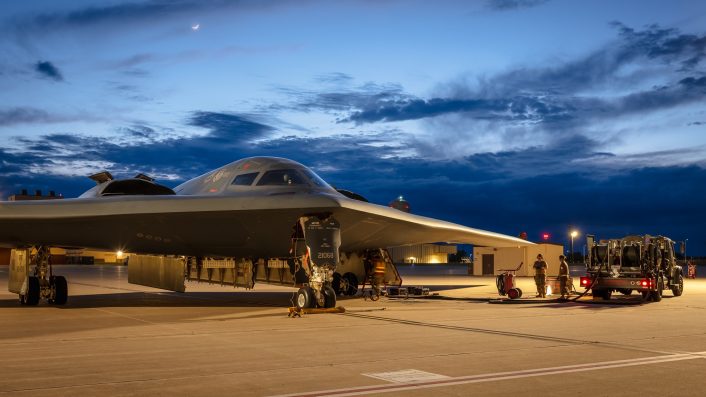
The time spent over the target was 25 minutes, with the main package concentrating on Fordow and Natanz as at least 24 Tomahawks flew towards Esfahan. Previous reports stated that as much as 30 TLAMs might have been launched on the third nuclear site.
“All three Iranian nuclear infrastructure targets were struck between 6:40 p.m. and 7:05 p.m. Eastern Standard Time – again, that’s about 2:10 in the morning local time in Iran – with the Tomahawk missiles being the last to strike at Esfahan to ensure we retained the element of surprise throughout the operation,” continued Caine. “Following weapons’ release, the Midnight Hammer strike package exited Iranian airspace and the package began its return home. We are unaware of any shots fired at the package on the way out.”
Likely footage of US Navy-launched Tomahawk cruise missiles hitting Iran’s Isfahan nuclear facility, as seen from nearby:pic.twitter.com/570NvdkPPH
— OSINTtechnical (@Osinttechnical) June 22, 2025
The deceptions which were put in place worked as planned, and the surprise effect was achieved, with Iran reportedly not able to react to the massive strike. Most of the Iranian Air Force and air defenses had already been destroyed by multiple waves of Israeli strikes, and the preemptive U.S. strikes might have destroyed the few that might have still presented a threat.
“Iran’s fighters did not fly, and it appears that Iran’s surface-to-air missile systems did not see us,” stated Caine. “Throughout the mission, we retained the element of surprise.”
Caine also provided a count of the weapon employed during Operation Midnight Hammer, although he did not delve into details.
“In total, U.S. forces employed approximatively 75 precision guided weapons during this operation,” said the General. “This included, as the President stated last night, 14 30,000-pound GBU-57 Massive Ordnance Penetrators, marking the first ever operational use of this weapon.”
Considering the 14 MOPs and 24 to 30 TLAMs launched on the three nuclear sites, this would indicate that the fighters in the strike package employed between 31 to 37 Precision Guided Munitions (PGM) as part of the preemptive strikes and the SEAD missions.
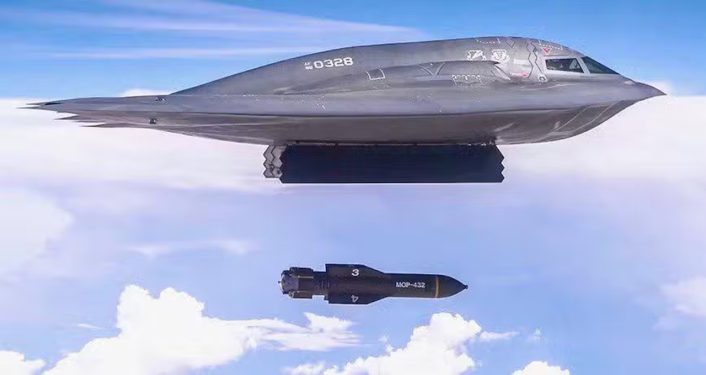
Battle Damage Assessment
Following the strike, the first questions to arise were whether the strike succeeded in destroying the underground structures. In fact, one of the main discussion points before the strikes was whether the sites were too deep underground even for the MOP, as Natanz was reportedly located about three floors underground and Fordow was dug far deeper into a mountain.
“I know the battle damage is of great interest,” said Caine. “Final battle damage will take some time, but initial battle damage assessments indicate that all three sites sustained extremely severe damage and destruction.”
High-resolution satellite images are already being shared online thanks to commercial providers such as Maxar. Obviously, the attention focused on Fordow, the main target.
Post-strike images of the Fordow fuel enrichment facility in Iran from @Maxar dated 22 June.
Large craters caused by the US strikes can be seen on the ridge above the underground complex. A layer of grey-blue ash covers the area around the site. pic.twitter.com/wzFNnUil7a
— John Pollock (@John_Pollock22) June 22, 2025
Two groups of closely positioned entry points for the bombs can clearly be seen by comparing satellite photos taken before and after the strike. The area appears to be covered by ashes and other residuals from the explosion, with the entry tunnels of the underground site sealed with dirt possibly because of the shockwave following the underground explosion and possible collapse.
The first image of Fordow has now been released, a set of munition entry holes are visible just above the suspected underground facility while signs of land subsidence is seen, possibly as the area of interest caved inwards as result of the strike pic.twitter.com/Fsl7Rc7lBn
— Damien Symon (@detresfa_) June 22, 2025
Impact points can also be noticed in the satellite images of the Natanz facility.
The impact crater from the B-2 strike on the Natanz enrichment facility is visible in this @Maxar imagery.
Images dating from the 15 June show damage from Israeli air strikes on the underground secition of the facility. Imagery from the 22 June shows a new large impact point. pic.twitter.com/spvEYODEgR
— John Pollock (@John_Pollock22) June 22, 2025
Satellite images now available also show damage at Esfahan, with before and after images showing extensive new damage caused by the Tomahawks.
Imagery via Maxar shows the destruction at the Isfahan Nuclear Facility in Iran that was struck by both Israel & the U.S. over the last few days https://t.co/OAXtrFj2t2 pic.twitter.com/xB9cFcxtar
— Damien Symon (@detresfa_) June 22, 2025
It is important to note that large movements of heavy machinery and vehicles were captured in satellite images before the strike at Fordow. The reason is unclear, with current theories ranging from an evacuation of the machinery used for the nuclear program, to reinforcement of the tunnels in anticipation of the strike or even a seal of the entry tunnels against a possible fallout.
IMPORTANT: Prior to the U.S. strikes at Fordow, imagery shows a possible logistics shuffle underway at the site, multiple trucks/heavy machinery were gathered at tunnel entrance of the facility on June 19-20th, 2025 https://t.co/p8NvYAHWVE
— Damien Symon (@detresfa_) June 22, 2025

